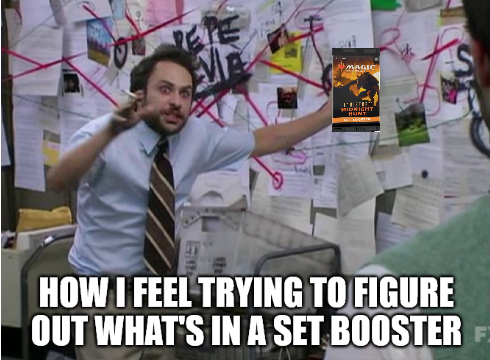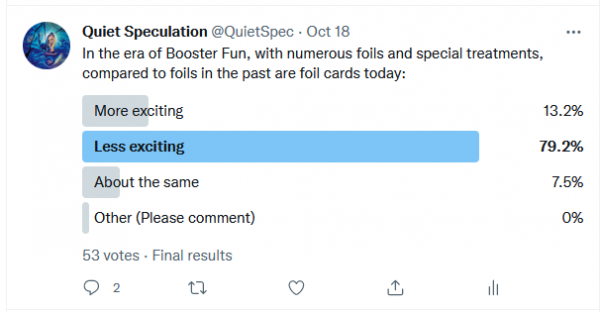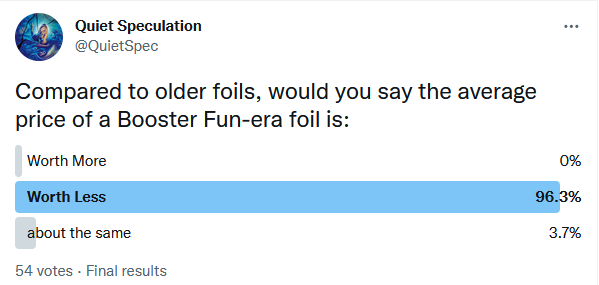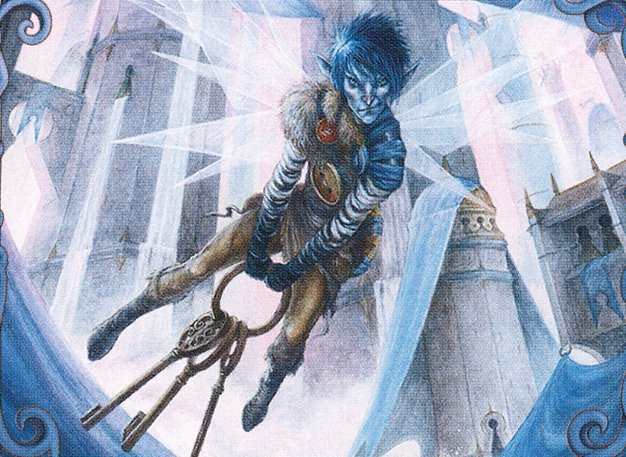Are you a Quiet Speculation member?
If not, now is a perfect time to join up! Our powerful tools, breaking-news analysis, and exclusive Discord channel will make sure you stay up to date and ahead of the curve.
Project Booster Fun
It sounds exciting. Dramatic even. Project Booster Fun. Making booster packs better. The reality of Project Booster Fun (PBF) is somewhat murkier when we break it down. According to Mark Rosewater in his article introducing Project Booster Fun (PBF), the inspiration for PBF came from a brainstorming session following the reorganization of Magic R&D into a studio model. The newly-organized studio for tabletop Magic sought to reinvigorate the tabletop Magic experience. Their goal, as Rosewater describes it, was to "improve the experience of opening a Magic booster pack." But what did this mean, and why did it need improving, to begin with?
The Problem With Booster Packs
Project Booster Fun attacked the same problem the FIRE Philosophy attempted to solve. Reduce the number of cards players opening packs not intended for Limited play deemed worthless. The FIRE Philosophy approach was to make common cards more powerful. PBF approached the problem from a different angle. "How do we make opening booster packs more exciting? Put more cool and beautiful versions of cards in them," Rosewater said in his article on Project Booster Fun.
PBF's solution was twofold. The first was to put more shiny things in packs in the form of foils and new treatments for cards not typically seen in premiere sets. The second was to introduce new types of booster packs that contained less common cards and more of these foils and special treatments. We'll get to those in a moment.
More Frequent Foils and New Card Treatments
As part of PBF, starting with Core Set 2020, Wizards increased the drop rate of foils from 1 in 67 cards to 1 in 45 cards. This increased the chance of getting a foil in booster packs from less than one in four booster packs to one in three booster packs. With Throne of Eldraine, they introduced new treatments of cards not usually done in premiere products, including Borderless Planeswalkers, Extended Art Frames, and Showcase Frames.
Showcase frames are treatments unique to the set in which they appear, and capture some of the aesthetic or vibe of the given set. These Showcase treatments can appear in regular booster packs, now called Draft Boosters, but appear at greater frequency and in greater numbers in Set Boosters and Collector Boosters. The more unique card treatments only appear in Set Boosters and Collector Boosters.
Collector and Set Boosters
Wizards introduced Collector Boosters with Throne of Eldraine, and Set Boosters starting with Zendikar Rising. With the stated goals of putting more of the cards players wanted in their hands, these products served as vehicles to sell the new card treatments Wizards was introducing and sounded like a win-win for all. But what exactly was inside the wrapper, and how much would it cost?
Collector Boosters come in 15-card packs with an elaborate breakdown of contents, which Rosewater goes into in his article, and a retail price around $20-$25 per booster pack, with 12 packs per Collector Booster Box. Set Boosters come in 12-card packs and 30 packs per Set Booster Box, and have their own elaborate breakdown of contents, outlined in this article, also by Rosewater.

The List
One of the selling points of Set Boosters, in addition to all the special card treatments, is the chance of opening cards from The List. Rosewater describes The List as "300 interesting cards from Magic's past." Not only did Wizards tout the list as a place where cards from throughout Magic's history would receive much-needed reprints, but The List would also serve as the only source for in-Magic versions of cards from Secret Lair Universes Beyond products, they wrote in this update.
The Takeaway
The first big takeaway from looking at these products is they are clearly more expensive than the normal Draft Booster Box, and with much fewer contents per box. Here are TCGPlayer listings of boxes from the most recent expansion Innistrad: Midnight Hunt:

The Collector Booster box is twice the price, for a third of the cards of a Draft Booster box. The Set Booster Box is about the same price as a Draft Booster box but has six fewer packs, 30 instead of 36, and three fewer cards per pack. This raises a few questions: Do the contents of these products justify the price? What does it mean when the more exciting product is more expensive? If these products are more expensive, does that mean their contents will in turn be more valuable? Does exciting equal valuable?
The Failure of Project Booster Fun

When everything is special, nothing is special. That is the essence of the issue with Project Booster Fun and with Collector and Set Boosters. Cramming more and more shiny, extended, alternate-whatever treatments of cards into packs only serves to devalue all but the rarest and most hard to come by versions of the cards. As for making opening packs more exciting, let's be real for a moment, anytime Wizards describes a product as exciting, that's really code for valuable. Are PBF foils more valuable?

Foils Are The New Draft Chaff
While the sample size of both of these polls is a bit small to make concrete declarations, the answers to each are overwhelmingly polarized. This tells us that the community sentiment regarding Project Booster Fun is the opposite of its intended goal. Are Project Booster Fun foils really worth less than older foils? Let's look at some QS Insider Price data of foil rares and mythics from four recent Magic sets and attempt to unpack it.
| BFZ | Eldraine | AFR | Midnight | |
| Total Value of Foil Rares/Mythics | $281.83 | $542.10 | $480.40 | $640.12 |
| Average Value Per Card | $4.14 | $3.76 | $3.10 | $3.72 |
| Total Number of Cards | 68 | 144 | 155 | 172 |
Looking at the data, community sentiment is correct that Project Booster Fun foils are worth less on average than sets before them. What has greatly increased though, is the volume of foils, including special treatments, from 68 with Battle For Zendikar, to 172 with Innistrad: Midnight Hunt. The special treatment foils are where most of the value of the set lies, accounting for $410.50 of the value of Midnight Hunt's $640.12 worth of rares and mythics. When you separate out the Showcase cards from the rest of the set, the average value of a Midnight Hunt foil rare or mythic is about $2.70.
Low Prices Can Be a Good Thing
Low prices for single cards are not all bad. The depressed prices of foils have also pushed down the prices of non-foils, making it easier than ever for players to acquire most of the cards they need for Standard short of the chasest of mythic rares. Even then though, cards like Alrund's Epiphany and Goldspan Dragon, two of the most played mythics in current Standard, are both under $40. This is something relatively unheard of in the era before Project Booster Fun.
At the end of the day, it is important to remember that the end goal of Project Booster Fun is getting players to buy more packs. Despite the problems of PBF, Hasbro's 2021 earnings reports clearly indicate Wizards has succeeded in their goal. If improvements were made to PBF, what is the best way to approach them?
The Path Forward
Recognizing that the goals of Wizards are to sell packs and make a profit, but wanting to see players get the most of their experience and the best bang for their buck at the same time, these are the changes I'd propose to satisfy all concerned. Note, that I'm not a professional game designer, nor a Wizards employee, just a life-long Magic fan who spends a lot of time thinking about the craft of designing and marketing Magic, and wanting to see it continue to thrive. If any Wizards employees happen to be reading this, feel free to use these ideas as you see fit.
Merge Set Boosters and Draft Boosters
Collector Boosters, containing only the choicest and most blinged-out of foils and special card treatments, are an ideal product for collectors seeking just those things. Set Boosters and Draft Boosters, on the other hand, have so much in common that it makes little sense to maintain them as separate products. It would not be difficult to take the gameplay-oriented structure of draft boosters and increase the drop rates of blinged-out showcase cards, replacing either commons, like-rarities, or some combination of both. Not only would this make the pack opening experience more exciting, but it would make the draft experience exciting in a way akin to how the Mystical Archive in Strixhaven draft made that format thrilling every playthrough.
Have The List Appear in Draft Boosters, and Eliminate the Chaff From Its Rotation
With Set Boosters and Draft Boosters merged into Deluxe Draft Boosters, cards from The List would now appear in the draft. While the 25% drop-rate at which they appeared in Set boosters would be a little too frequent for draft, a rate somewhere in the middle between there, and the one-per-case or so drop-rate of the Inventions of Kaladesh would be ideal. If these cards are going to appear at a rate enough to make opening them something special, it also makes sense that the contents of The List feel better curated than 300 presses of the Scryfall Random button. Tolarian Community College did an excellent video on fixing The List, and his ideas could easily be incorporated into this change.
Raise the Price of Draft Boosters
While this might be the least popular of these suggestions, the price of Draft Booster boxes for premiere sets has been about the same for nearly 15 years, if not longer. If Draft Boosters are going to be juiced into Deluxe Draft Boosters, it makes sense that the price per booster should be about in line with the current prices of Set Boosters to reflect this premium, especially if they maintain the 36-packs per box quantity we've come to associate with Draft Booster boxes.
Convert Theme Boosters Into Jump-In Products.
One result of Project Booster fun which we've yet to discuss until now is Theme Boosters. Theme Boosters are oversized boosters of 35 cards, built around a specific theme from their respective set. This could be color, as was the case with Throne of Eldraine and Innistrad: Midnight Hunt, or some other theme entirely. These boosters are very close in kin to the Jumpstart mini-decks from 2020, and it doesn't seem too much of a stretch to convert Theme Boosters into Standard-only Jumpstart, or Jump-In products, as they referred to them in a recent Magic Arena event.
Continuous Improvement
Magic: the Gathering is one of the greatest games ever made, made by some of the smartest people in the world. Much of the history of Magic design is a history of iteration, with designers learning lessons from the failures and building on the successes that have come before. It's my hope that addressing the shortcomings of Project Booster Fun will help ensure that we continue experiencing the joys of cracking open fresh packs for years to come.





